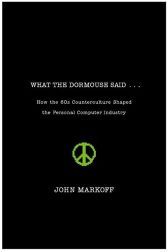The true origins of the personal computer


In the San Francisco Bay area, in the midst of Vietnam War protests, acid trips, folk dancing, minicomputers, est, Spacewar, the Free Speech Movement and youthful idealism, a diverse group of individuals--both buttoned-up scientists and hippie nerds--saw the potential to scale from world of punch cards, time-sharing and minicomputers to powerful computers designed for individuals. Markoff chronicles the interactions of characters--such as Doug Englebart, Myron Stolaroff, Larry Tesler, Alan Kay, John McCarthy, Stewart Brand, John Draper, Bill Duvall, Larry Roberts, Dan Ingalls, Bill English, Fred Moore, Bob Taylor and Jim Warren, to name a few of the principle players--who pioneered the personal computing movement. Along the way Ken Kesey, Joan Baez, Werner Erhard, David Harris, The Grateful Dead and other countercultural figures intersect with the computer crowd.
It's a fascinating look at the Silicon Valley culture and the personal computer industry in its youth. Thirty years later, the concepts formulated at the Stanford AI Lab, Englebart's Augment Lab and at Xerox PARC are still works in progress. The mouse, windows, icons and cut and paste are legacies of that past. We are closer to the goal of a connected computer (PDA, cell phone) for everyone on the planet, as well as "free" software. Along the way, a few got rich and a critical IT industry evolved.
In many ways, open source and the Internet are a continuation of what started in the 1960's as "power to the people." Once again, those with a passion for digital technology who are not part of the "establishment" are formulating new concepts and use models, forcing a rethinking of music, media, film and other industries. We won't know how it turns out for a while, but this transformation is already the subject of many books and blogs. Thirty years from now, or a bit sooner, someone will write a book (or craft an interactive, multimedia experience) that chronicles the wild and contentious period of personalized computing between 1995 and 2010, against a backdrop of globalization, wars, politics, greed, bubble bursting and invention. It will be more of a tale of heroes and villains than Markoff's book, which is mostly about heroes who toiled in relative anonymity. In this current era, we have a more complex relationship with technology. It both empowers individuals and eliminates privacy. It impacts every part of our lives, and is woven into the cultural fabric, especially among the youth. Many stories are yet to written about how the cultural influences, including technology, of this decade will shape the future.